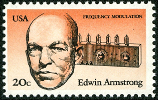 Edwin H. Armstrong
Edwin H. Armstrong 
 Edwin H. Armstrong
Edwin H. Armstrong 
Regenerative Circuit
While growing up Armstrong had experimented with the early, temperamental, "gassy" Audions. Spurred by the later discoveries, he developed a keen interest in gaining a detailed scientific understanding of how vacuum-tubes worked. In conjunction with Professor Morecroft he used an oscillograph to conduct comprehensive studies. His breakthrough discovery was determining that employing positive feedback (also known as "regeneration") produced amplification hundreds of times greater than previously attained, with the amplified signals now strong enough so that receivers could use loudspeakers instead of headphones. Further investigation revealed that when the feedback was increased beyond a certain level a vacuum-tube would go into oscillation, thus could also be used as a continuous-wave radio transmitter.
Following the end of World War I Armstrong enlisted representation by the law firm of Pennie, Davis, Martin and Edmonds. In order to finance his legal expenses he began issuing non-transferable licenses for use of the regenerative patents to a select group of small radio equipment firms, and by November 1920 seventeen companies had been licensed. These licensees paid 5% royalties on their sales which were restricted to only "amateurs and experimenters". Meanwhile, Armstrong reviewed his options for selling the commercial rights to his work. Although the obvious candidate was the Radio Corporation of America (RCA), on October 5, 1920 the Westinghouse Electric & Manufacturing Company took out an option for $335,000 for the commercial rights for both the regenerative and superheterodyne patents, with an additional $200,000 to be paid if Armstrong prevailed in the regenerative patent dispute. Westinghouse exercised this option on November 4, 1920.
Legal proceedings related to the regeneration patent became separated into two groups of court cases. An initial court action was triggered in 1919 when Armstrong sued de Forest's company in district court, alleging infringement of patent 1,113,149. This court ruled in Armstrong's favor on May 17, 1921. But a second line of court cases, the result of the patent office interference hearing, would have a different outcome. The interference board had also sided with Armstrong, but he was unwilling to settle with de Forest for less than what he considered full compensation. Thus pressured, de Forest decided to continue his legal defense, and appealed the interference board decision to the District of Columbia district court. On May 8, 1924, that court ruled that it was de Forest who should be considered regeneration's inventor. Armstrong (along with much of the engineering community) was shocked by this course of events, and his side appealed this unexpected decision. But although the legal proceeding twice went before the U.S. Supreme Court, in 1928 and 1934, he was unsuccessful in overturning the decision.
In response to the second Supreme Court decision upholding de Forest as the inventor of regeneration, Armstrong attempted to return his 1917 IRE Medal of Honor, which had been awarded "in recognition of his work and publications dealing with the action of the oscillating and non-oscillating audion". However, the organization's board refused to let him, and issued a statement that it "strongly affirms the original award".
Tansferable licenses for use of the regenerative patents to a select group of small radio equipment firms, and by November 1920 seventeen companies had been licensed. These licensees paid 5% royalties on their sales which were restricted to only "amateurs and experimenters". Meanwhile, Armstrong reviewed his options for selling the commercial rights to his work. Although the obvious candidate was the Radio Corporation of America (RCA), on October 5, 1920 the Westinghouse Electric & Manufacturing Company took out an option for $335,000 for the commercial rights for both the regenerative and superheterodyne patents, with an additional $200,000 to be paid if Armstrong prevailed in the regenerative patent dispute. Westinghouse exercised this option on November 4, 1920.
Super-Regeneration Circuit
Superheterodyne Circuit
During this period Armstrong's most significant accomplishment was the development of a "supersonic heterodyne" ➙ soon shortened to "superheterodyne" radio receiver circuit. This circuit made radio receivers more sensitive and selective and is still extensively used today. The key feature of the superheterodyne approach is the mixing of the incoming radio signal with a locally generated, different frequency signal within a radio set. This circuit is typically referred to as the mixer. The end result is a fixed, unchanging intermediate frequency, or I.F. signal which is more easily amplified and detected by subsequent circuit stages that follow the mixer. In 1919, Armstrong filed an application for a U.S. patent of the superheterodyne circuit which was issued the next year. This patent was subsequently sold to Westinghouse. The patent would be challenged, however, triggering yet another patent office interference hearing. Armstrong ultimately lost this patent battle; although the outcome was less controversial than that involving the regeneration proceedings.
The challenger was Lucien Levy of France who had also worked developing Allied radio communication during World War I. He had been awarded French patents in 1917 and 1918 that covered some of the same basic ideas used in Armstrong's superheterodyne receiver. AT&T, which was interested in radio development at this time, primarily for point-to-point extensions of its wired telephone exchanges, purchased the U.S. rights to Levy's patent and contested Armstrong's grant. The subsequent court reviews continued until 1928, when the District of Columbia Court of Appeals disallowed all nine claims of Armstrong's patent, assigning priority for seven of the claims to Levy, and one each to Ernst Alexanderson of General Electric and Burton W. Kendall of Bell Laboratories.
Although most early radio receivers used regeneration Armstrong approached RCA's David Sarnoff, who he had known since giving a demonstration of his regeneration receiver in 1913, about the corporation offering superheterodynes as a superior offering to the general public. (The ongoing patent dispute was not a hindrance, because extensive cross-licensing agreements signed in 1920 and 1921 between RCA, Westinghouse and AT&T meant that Armstrong could freely use the Levy patent.) Superheterodyne sets were initially thought to be prohibitively complicated and expensive as the initial designs required multiple tuning knobs and used nine vacuum-tubes. However, in conjunction with RCA engineers, Armstrong developed a simpler, less costly design. RCA introduced its superheterodyne Radiola sets in the U.S. market in early 1924, and they were an immediate success, dramatically increasing the corporation's profits. These sets were considered so valuable that RCA would not license the superheterodyne to other U.S. manufacturing companies until 1930.
Wide-band FM radio
One approach considered as a potential solution had been the use of frequency modulation (FM) transmissions, where, in order to encode audio, instead of varying (technically known as "modulating") the amplitude (strength) of a radio signal, as was done for AM transmissions, the frequency was varied. However, in 1922 John Renshaw Carson of AT&T, inventor of Single-sideband modulation (SSB), had published a Proceedings of the IRE paper which included a detailed mathematical analysis which showed that FM transmissions did not provide any improvement over AM. Although the Carson bandwidth rule for FM is still important today, this review turned out to be incomplete, because it analyzed only what is now known as "narrow-band" FM.
In early 1928 Armstrong began researching the capabilities of frequency modulation. Although there were few others involved in FM research at this time, he did have knowledge of a project being conducted by RCA engineers, who were investigating whether FM shortwave transmissions were less susceptible to fading than AM. In 1931 these engineers constructed a successful FM shortwave link transmitting the Schmeling-Stribling fight broadcast from California to Hawaii, and noted at the time that the signals seemed to be less affected by static, but the project made little further progress.
Working in secret in the basement laboratory of Columbia's Philosophy Hall, Armstrong slowly developed what eventually resulted in wide-band FM, in the process discovering significant advantages over the earlier "narrow-band" FM transmissions. He was granted five U.S. patents covering the basic features of new system on December 26, 1933. Initially, the primary claim was that his FM system was effective at filtering out the noise produced in receivers by vacuum tubes.
Armstrong had a standing agreement to give RCA the right of first refusal to his patents. In 1934 he made a presentation of his new system to RCA president Sarnoff. Sarnoff was somewhat taken aback by its complexity, as he had hoped it would be possible to eliminate static merely by adding a simple device to existing receivers. From May 1934 until October 1935 Armstrong conducted field tests of his FM technology from an RCA laboratory located on the 85th floor of the Empire State Building in New York City. An antenna attached to the building's spire transmitted signals for distances up to 80 miles (130 km). These tests helped demonstrate FM's static-reduction and high-fidelity capabilities. However RCA, which was heavily invested in perfecting television broadcasting, chose not to invest in FM, and instructed Armstrong to remove his equipment.
In June 1936, Armstrong gave a formal presentation of his new system at the U.S. Federal Communications Commission (FCC) headquarters in Washington, D.C. For comparison, he played a jazz record using a conventional AM radio, then switched to an FM transmission. A United Press correspondent was present, and recounted in a wire service report that: "If the audience of 500 engineers had shut their eyes they would have believed the jazz band was in the same room. There were no extraneous sounds." Moreover, "Several engineers said after the demonstration that they consider Dr. Armstrong's invention one of the most important radio developments since the first earphone crystal sets were introduced." Armstrong was quoted as saying he could "visualize a time not far distant when the use of ultra-high frequency wave bands will play the leading role in all broadcasting", although the article noted that "A switchover to the ultra-high frequency system would mean the junking of present broadcasting equipment and present receivers in homes, eventually causing the expenditure of billions of dollars."
In the late 1930s, as technical advances made it possible to transmit on higher frequencies, the FCC investigated options for increasing the number of broadcasting stations, in addition to ideas for better audio quality, known as "high-fidelity". In 1937 it introduced what became known as the Apex band, consisting of 75 broadcasting frequencies from 41.02 to 43.98 MHz. As on the standard broadcast band these were AM stations, but with higher quality audio — in one example, a frequency response from 20 Hz to 17,000 Hz +/- 1 dB — because station separations were 40 kHz instead of the 10 kHz spacings used on the original AM band. Armstrong worked to convince the FCC that a band of FM broadcasting stations would be a superior approach. That year he financed the construction of the first FM radio station, W2XMN (later KE2XCC) at Alpine, New Jersey. FCC engineers had believed that transmissions using high frequencies would travel little farther than line-of-sight distances, limited by the horizon. However, when operating with 40 kilowatts on 42.8 MHz, the station could be clearly heard 100 miles (160 km) away, matching the daytime coverage of a full power 50-kilowatt AM station.
FCC studies comparing the Apex station transmissions with the Armstrong FM system concluded that his approach was superior. In early 1940, the FCC held hearings on whether to establish a commercial FM service. Following this review, the FCC announced the establishment of an FM band effective January 1, 1941, consisting of forty 200 kHz-wide channels on a band from 42-50 MHz, with the first five channels reserved for educational stations. Existing Apex stations were notified that they would not be allowed to operate after January 1, 1941 unless they converted to FM.
Although there was interest in the new FM band by station owners, construction restrictions that went into place during World War II limited the growth of the new service. Following the end of World War II, the FCC moved to standardize its frequency allocations. One area of concern was the effects of tropospheric and Sporadic E propagation, which at times reflected station signals over great distances, causing mutual interference. A particularly controversial proposal, spearheaded by RCA, was that the FM band needed to be shifted to higher frequencies in order to avoid this potential problem. This reassignment was fiercely opposed as unneeded by Armstrong, but in the end he lost. The FCC made its decision final on June 27, 1945. It allocated one hundred FM channels from 88–108 MHz, and assigned the former FM band to "non government fixed and mobile" (42–44 MHz), and television channel 1 (44–50 MHz). A period of allowing existing FM stations to broadcast on both low and high bands ended at midnight on January 8, 1949, at which time any low band transmitters had to be shut down, officially making obsolete 395,000 receivers that had already been purchased by the public for the original band. Although converters allowing low band FM sets to receive high band were manufactured, they ultimately proved to be complicated to install, and often as (or more) expensive than buying a new high band set outright.
Armstrong felt the FM band reassignment had been inspired primarily by a desire to cause a disruption that would limit FM's ability to challenge the existing radio industry, including RCA's AM radio properties that included the NBC radio network, plus the other major networks including CBS, ABC and Mutual. The change was also thought to have been favored by AT&T, as the elimination of FM relaying stations would require radio stations to lease wired links from that company. Particularly galling was the fact that the FCC then assigned TV channel 1 to the 44-50 MHz segment of the old FM band, despite the fact that in 1941 the FCC had adopted FM sound as part of the NTSC television standard, moreover, the video portions of the standard were even more susceptible to interference than the audio. Channel 1 eventually had to be deleted as well, with all TV broadcasts licensed at frequencies 54 MHz or higher, and in the United States these frequencies are no longer widely used for emergency first responders, those services having moved mostly to UHF.
Although the FM band shift was an economic setback, there was still reason for optimism, and a book published in 1946 by Charles A. Siepmann heralded FM stations as "Radio's Second Chance". In late 1945, Armstrong contracted with John Orr Young, founding member of the public relations firm Young & Rubicam, to conduct a national campaign promoting FM broadcasting, especially by educational institutions. Article placements promoting both Armstrong personally and FM were made with general circulation publications including The Nation, Fortune, the New York Times, Atlantic Monthly, and The Saturday Evening Post.
In 1940, RCA offered Armstrong $1,000,000 for a non-exclusive, royalty-free license to use his FM patents. But he refused this offer, primarily because he felt this would be unfair to the other licensed companies, which had to pay 2% royalties on their sales. Over time this impasse with RCA would come to dominate Armstrong's life. RCA countered by conducting its own FM research, eventually developing what it claimed was a non-infringing FM system. The corporation also encouraged other companies to stop paying royalties to Armstrong. Outraged by this turn of events, in 1948 Armstrong filed suit against RCA and the National Broadcasting Company, accusing them of patent infringement and that they had "deliberately set out to oppose and impair the value" of his invention, for which he requested treble damages. Although he was confident that this suit would be successful and result in a major monetary award, the protracted legal maneuvering that followed eventually began to impair his finances, especially after his primary patents expired in late 1950.
![]() Excerpts From Wikipedia opens in new browser window
Excerpts From Wikipedia opens in new browser window
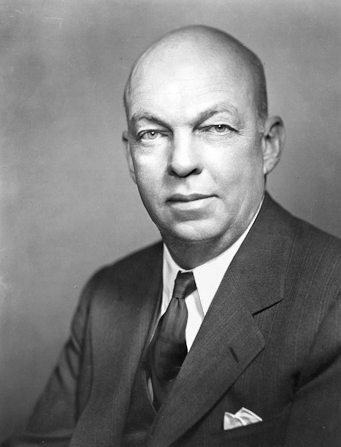 Edwin Howard Armstrong (December 18, 1890 ➙ January 31, 1954) was an American electrical engineer and inventor, best known for developing FM (frequency modulation) radio and the superheterodyne receiver system. He held 42 patents and received numerous awards, including the first Medal of Honor awarded by the Institute of Radio Engineers (now IEEE), the French Legion of Honor, the 1941 Franklin Medal and the 1942 Edison Medal. He was inducted into the National Inventors Hall of Fame and included in the International Telecommunication Union's roster of great inventors.
Edwin Howard Armstrong (December 18, 1890 ➙ January 31, 1954) was an American electrical engineer and inventor, best known for developing FM (frequency modulation) radio and the superheterodyne receiver system. He held 42 patents and received numerous awards, including the first Medal of Honor awarded by the Institute of Radio Engineers (now IEEE), the French Legion of Honor, the 1941 Franklin Medal and the 1942 Edison Medal. He was inducted into the National Inventors Hall of Fame and included in the International Telecommunication Union's roster of great inventors.
Armstrong's "feed back" circuit drawing, from Radio Broadcast vol. 1 no. 1 1922.
Armstrong began working on his first major invention while still an undergraduate at Columbia. In late 1906, Lee de Forest had invented the three-element (triode) "grid Audion" vacuum-tube. How vacuum tubes worked was not understood at the time. De Forest's initial Audions did not have a high vacuum and developed a blue glow at modest plate voltages; De Forest improved the vacuum for Federal Telegraph. By 1912, how vacuum tubes worked was understood, and the advantages of high vacuum tubes was appreciated.
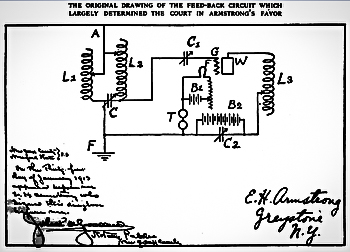 Beginning in 1913 Armstrong prepared a series of comprehensive demonstrations and papers that carefully documented his research, and in late 1913 applied for patent protection covering the regenerative circuit. On October 6, 1914, U.S. patent 1,113,149 was issued for his discovery. Although Lee de Forest initially discounted Armstrong's findings, beginning in 1915 de Forest filed a series of competing patent applications that largely copied Armstrong's claims, now stating that he had discovered regeneration first, based on August 6, 1912 notebook entry, while working for the Federal Telegraph company, prior to the January 31, 1913 date recognized for Armstrong. The result was an interference hearing at the patent office to determine priority. De Forest was not the only other inventor involved ➙ the four competing claimants included Armstrong, de Forest, General Electric's Langmuir, and Alexander Meissner, who was a German national, which led to his application being seized by the Office of Alien Property Custodian during World War I.
Beginning in 1913 Armstrong prepared a series of comprehensive demonstrations and papers that carefully documented his research, and in late 1913 applied for patent protection covering the regenerative circuit. On October 6, 1914, U.S. patent 1,113,149 was issued for his discovery. Although Lee de Forest initially discounted Armstrong's findings, beginning in 1915 de Forest filed a series of competing patent applications that largely copied Armstrong's claims, now stating that he had discovered regeneration first, based on August 6, 1912 notebook entry, while working for the Federal Telegraph company, prior to the January 31, 1913 date recognized for Armstrong. The result was an interference hearing at the patent office to determine priority. De Forest was not the only other inventor involved ➙ the four competing claimants included Armstrong, de Forest, General Electric's Langmuir, and Alexander Meissner, who was a German national, which led to his application being seized by the Office of Alien Property Custodian during World War I.
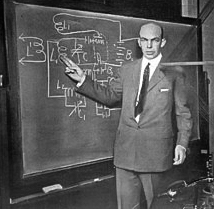 Armstrong explaining the superregenerative circuit, New York, 1922 The regeneration legal battle had one serendipitous outcome for Armstrong. While he was preparing apparatus to counteract a claim made by a patent attorney, he "accidentally ran into the phenomenon of super-regeneration", where, by rapidly "quenching" the vacuum-tube oscillations, he was able to achieve even greater levels of amplification. A year later, in 1922, Armstrong sold his super-regeneration patent to RCA for $200,000 plus 60,000 shares of corporation stock, which was later increased to 80,000 shares in payment for consulting services. This made Armstrong RCA's largest shareholder, and he noted that "The sale of that invention was to net me more than the sale of the regenerative circuit and the superheterodyne combined". RCA envisioned selling a line of super-regenerative receivers until superheterodyne sets could be perfected for general sales, but it turned out the circuit was not selective enough to make it practical for broadcast receivers.
Armstrong explaining the superregenerative circuit, New York, 1922 The regeneration legal battle had one serendipitous outcome for Armstrong. While he was preparing apparatus to counteract a claim made by a patent attorney, he "accidentally ran into the phenomenon of super-regeneration", where, by rapidly "quenching" the vacuum-tube oscillations, he was able to achieve even greater levels of amplification. A year later, in 1922, Armstrong sold his super-regeneration patent to RCA for $200,000 plus 60,000 shares of corporation stock, which was later increased to 80,000 shares in payment for consulting services. This made Armstrong RCA's largest shareholder, and he noted that "The sale of that invention was to net me more than the sale of the regenerative circuit and the superheterodyne combined". RCA envisioned selling a line of super-regenerative receivers until superheterodyne sets could be perfected for general sales, but it turned out the circuit was not selective enough to make it practical for broadcast receivers.
The United States entered into World War I in April 1917, and later that year Armstrong was commissioned as a Captain in the U.S. Army Signal Corps, and assigned to a laboratory in Paris, France to help develop radio communication for the Allied war effort. He returned to the United States in the fall of 1919, after being promoted to the rank of Major. (During both world wars, Armstrong gave the U.S. military free use of his patents.)
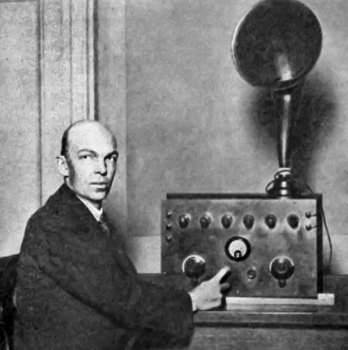 "Static" interference and extraneous noises caused by sources such as thunderstorms and electrical equipment bedeviled early radio communication using amplitude modulation (AM) and perplexed numerous inventors attempting to eliminate it. Many ideas for static elimination were investigated, with little success. In the mid-1920s, Armstrong began researching whether he could come up with a solution. He initially, and unsuccessfully, attempted to resolve the problem by modifying the characteristics of existing AM transmissions.
"Static" interference and extraneous noises caused by sources such as thunderstorms and electrical equipment bedeviled early radio communication using amplitude modulation (AM) and perplexed numerous inventors attempting to eliminate it. Many ideas for static elimination were investigated, with little success. In the mid-1920s, Armstrong began researching whether he could come up with a solution. He initially, and unsuccessfully, attempted to resolve the problem by modifying the characteristics of existing AM transmissions.
 Denied the marketing and financial clout that RCA would have brought, Armstrong decided to finance his own development and form ties with smaller members of the radio industry, including Zenith and General Electric, to promote his invention. Armstrong thought that FM had the potential to replace AM stations within 5 years, which he promoted as a boost for the radio manufacturing industry, then suffering from the effects of the Great Depression, since making existing AM radio transmitters and receivers obsolete would necessitate that stations buy replacement transmitters and listeners purchase FM-capable receivers. In 1936 he published a landmark paper in the Proceedings of the IRE that documented the superior capabilities of using wide-band FM. (This paper would be reprinted in the August 1984 issue of Proceedings of the IEEE.) A year later, a paper by Murray G. Crosby (inventor of Crosby system for FM Stereo) in the same journal provided further analysis of the wide-band FM characteristics, and introduced the concept of "threshold", demonstrating that there is a superior signal to noise ratio when the signal is stronger than a certain level.
Denied the marketing and financial clout that RCA would have brought, Armstrong decided to finance his own development and form ties with smaller members of the radio industry, including Zenith and General Electric, to promote his invention. Armstrong thought that FM had the potential to replace AM stations within 5 years, which he promoted as a boost for the radio manufacturing industry, then suffering from the effects of the Great Depression, since making existing AM radio transmitters and receivers obsolete would necessitate that stations buy replacement transmitters and listeners purchase FM-capable receivers. In 1936 he published a landmark paper in the Proceedings of the IRE that documented the superior capabilities of using wide-band FM. (This paper would be reprinted in the August 1984 issue of Proceedings of the IEEE.) A year later, a paper by Murray G. Crosby (inventor of Crosby system for FM Stereo) in the same journal provided further analysis of the wide-band FM characteristics, and introduced the concept of "threshold", demonstrating that there is a superior signal to noise ratio when the signal is stronger than a certain level.
![]() Return to Radio Pictures
Return to Radio Pictures
![]() Return to MCRN Home
Return to MCRN Home